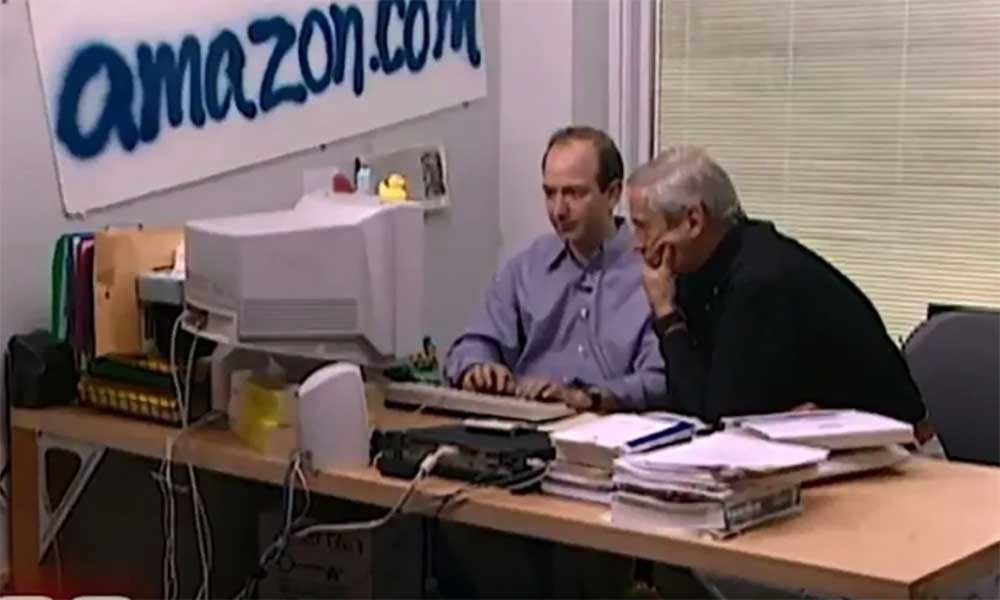
History of the Amazon Logo Design Evolution
If there is a captivating story behind a reputable brand today, Amazon?s history ranks first.
Amazon, the giant in the retail business that flipped the world of commerce upside down, has one of the most interesting histories any other brand has behind it.
What started as a small online book store in 1994 is now a $ 1 trillion worth company.
How did this happen?
Through years and years of evolution and innovation in which the company understood the fast-changing trends among consumers.
So, from its start as an online book store, Amazon has since developed into a tech giant that sells almost anything from electronics to movies, music, clothing, groceries, and even houses.
Yet, the brand?s size and the type of product it sells aren?t the only lenses through which we can see its evolution.
One of the most famous constant innovations that Amazon had was in its logo redesigns.
And, it seems that the company understood a principle that most brands fail to understand today: its business logo doesn?t just represent an assembly of symbols, letters, shapes, and colours but an essential part of the existence and evolution of the company it represents.
And the company?s logo indeed played a crucial role in the brand?s success.
The origins of Amazon

First things first, to understand how the Amazon logo design played a vital role in today?s company success, we must learn a thing or two about the origins of the brand.
It all started in 1994 when Jeff Bezos founded the company under the name ?Cadabra?.
Yet, the first name of the company only survived for less than a year as its founder decided to change it to ?Amazon? after realising the phonic resemblance of the original name to the word ?cadaver?.
Today?s tech giant was initially a small online book store which, surprisingly, grew incredibly fast, generating a $20.000 revenue a week in the first two months since its appearance on the market.
Yet, what made Amazon one of the only vital players left standing on the market in 2000 when the dot-com hype appeared was its strategy of investing all its profit into growth and expansion.
You may also like: 10 Steps to Creating the Perfect Product Label
So, this strategy made the company achieve a stunning profit of $5 million in 2001.
Since its first significant success, Amazon never looked back again but only forward growing to be one of the most popular tech giants today.
And, to show how its current logo aligns with the success and growth the company has today, just like its logo shows, Amazon sells everything from A to Z.
The History of the Amazon logo Design
The rapid growth of the company isn?t the only fascinating story behind the brand.
The development and evolution of its logo designs are another element in its history that made the brand famous for its constant innovation.
And with each new logo design the company had from its beginning until the present day, it only succeeded to transmit this message to their customers.
#1 Amazon logo (1995)

Amazon?s first logo was the literal interpretation of the company?s name: a blue background and the letter ?A? with a shape of a river inside, plus a caption that showed the ambitious goals of the company declaring the brand ?Earth?s biggest bookstore?.
Since the initial logo of the company was built somehow at the beginning of the digital era and there were very few or poor-quality tools for logo design, many critics had few negative things to say about it.
So, many said that it was difficult to read, busy, and some even called the river association within the logo a ?clich?.
Yet, even if it wasn?t the most well-constructed logo, it only represented the company for a very short time, until 1997 to be more precise.
#2 Amazon logo (1997)

In 1997, the original Amazon logo design was replaced with a more refined and well-constructed version that started to reflect the company?s growth.
It seems like the company somehow speculated that in the next years of that time the dot-com hype was about to burst since it incorporated it within its second version of its logo.
So, the 1997?s logo version resulted in a simpler and more representative one.
Yet, the second version of the logo was still not professional enough to show the real value of the company.
It was pretty clear that the brand?s logo was still trying to find its footing.
#3 Amazon logo (1998)

Only one year later, the logo suffered some new changes which made it look somehow closer to what we know today?s Amazon logo to look.
You may also like: App Icon Design ? 4 Tips for Better iOS & Android Icons
The new logo included the ?amazon? word written with upper-case letters and a giant yellow ring for the ?O? letter of its name.
This version was undoubtedly one of the most significant changes in its design and took the brand?s logo one huge step closer to the design of the logo as it is these days.
Yet, the version only survived a short period after the brand decided it needed a new update and reinvented its image.
#4 Amazon logo (1998?2000)

The second 1998 version of the Amazon logo design dropped the upper-case approach and reverted to the lower-case version.
Experts believe that while the upper-case version of the logo made the brand look less approachable, switching back to the lower-case version helped it appear more accessible again by eliminating the sense of authority of the 1998 version.
This version included the ?amazon.com? words underlined by an orange line curving down which represented the first form of the current smiley face covered in the brand?s logo today.
Moreover, what made this version of the logo contribute to making the company more popular was the colour choice made by the designers.
According to the colour psychology, orange, especially the orange shade used by Amazon, represents joy and warmth, which somehow reshaped the company?s reputation to a friendlier one among consumers.
Also, the association with the black colour is even more representative of the values of the company.
In the Amazon logo design, black is a symbol of the dominance and the elegance of the company.
#5 Amazon logo (2000)

The logo introduced in 2000 is a very similar version of today?s logo.
It includes the orange line that represents a smiley face which starts from the letter ?A? to the letter ?Z?, ending with an arrow.
Yet, the orange line no longer curved down but up in this new logo version.
Compared to all the previous logo versions of the company, this one truly reflects the growth and evolution of the tech giant.
The orange line is a symbol that represents the fact that the brand is now able to provide customers with everything from ?a? to ?z?.
You may also like: Good Design Will Help You Sell More ? Design as a Sales Tool
Moreover, the new logo contributed immensely to the company?s marketing strategy at that time as well.
How? The brand decided to use the orange smile as a design element for the shipping boxes used to send the orders to its customers.
And, this marketing strategy resulted in the association of the company by delivering ?smiles? to the doors of the customers.
#6 Amazon logo (2012 ? present day)

In 2012, the Amazon logo design undergone through new significant changes made, once again, by the designer who created the initial logo of the company, Turner Duckworth.
This version is, in fact, the most symbolic design which represents the business growth of the brand.
The new design dropped the ?.com? part of the logo which signifies the fact that the company has now expanded beyond the digital world with no more limitations.
Today, the company is investing in strategies and business opportunities beyond the internet, such as brick-and-mortar stores.
Moreover, the company dropped the self-proclamation strategy as the ?earth?s biggest bookstore? used in the initial versions of the logos.
And with over 100 million subscribers, the brand doesn?t even have to include such big words in its logo to show its immense success since everybody already knows it.
Nowadays, the Amazon smile is just as famous as the logo itself or the history of the company?s logo redesigns.
And, this is an excellent example of why all brands should have versatile logos that can be used in various ways for marketing.
To conclude, Amazon learned a fundamental lesson through its ever-changing logo design strategy and that is ?less is more?.
The brand understood that the perfect logo that will work is one that is simple and memorable at the same time.
Moreover, it also offers a great insight into what the company brings to the table: a friendly attitude towards customers and a multitude of products from a to z that will bring smiles on its customers? faces.
Author Bio: Kristin Savage nourishes, sparks and empowers using the magic of a word. Along with pursuing her degree in Creative Writing, Kristin was gaining experience in the publishing industry, with expertise in marketing strategy for publishers and authors. Now she works as a freelance writer at SupremeDissertations.
Originally published at https://inkbotdesign.com on January 10, 2020.


